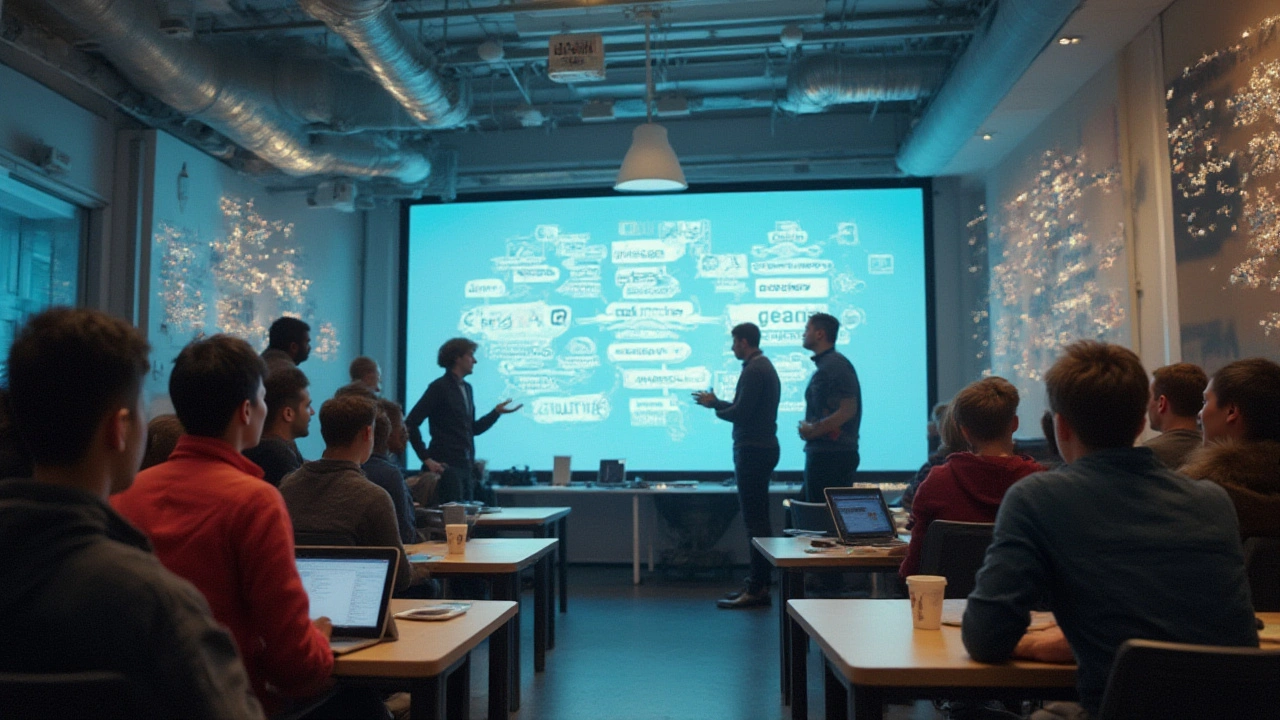Picture yourself a year from now, building an app from scratch or landing a job where you spend your days solving real-world problems with code. Right now, the demand for developers keeps breaking records, with more than 28 million software developers worldwide and that number still growing fast. But here's the crazy part: tech giants are desperate for skilled coders, even those without a degree. So, if you’re thinking, "I want in," you’re in good company—and you’re right on time. The journey from total newcomer to capable programmer is no longer reserved for Silicon Valley insiders or computer science students; today, people from all walks of life, from teenagers at home to folks switching careers in their 40s, are making the leap.
If you’re picturing endless nights drinking coffee and wrestling with cryptic errors, you’re not wrong—but you’re missing the bigger picture. It’s about picking the right languages, following a clear path, learning smart, and knowing when to ask for help instead of getting stuck. There’s no magic one-size-fits-all method, but some proven strategies work better, save you time, and give you the edge when you finally face those 'whiteboard interviews' or want to ship your first real project. Ready for details? Let’s talk about the building blocks of becoming a programmer in today’s world.
Your First Building Blocks: Choosing a Language and Setting Up
One of the first things new programmers trip over is the "which language should I learn first?" question. The answer is simpler than you think: start with one that fits what you want to do, but make sure it's a language that's in-demand, easy to find resources for, and has a supportive community. Python is the reigning champ for most beginners—and it’s still one of my favorites, mostly because my daughter Skylar picked it up before she even turned twelve. It reads almost like English, and you can do everything from basic automation to building websites, analyzing data, or dipping your toes in machine learning. JavaScript, on the other hand, is your best bet if you want to build anything for the web.
But picking a language is just step one. The real win comes from setting up your system properly and learning to use the core tools that programmers rely on every day. If you’re on Windows, installing Python using Anaconda or the standard installer is easy; Mac users have it even easier, and for Linux? Devs practically live on the command line, so you’ll fit right in. Don’t let setup slow you down—if you get stuck, jump into a community like Stack Overflow or the r/learnprogramming subreddit. You’ll be surprised how many people are happy to help you out, often in minutes.
Here’s a data nugget that shows why language choice matters:
| Language | Popularity Rank (2025) | Main Use Case |
|---|---|---|
| Python | 1 | Web, data, AI, scripting |
| JavaScript | 2 | Web apps, front-end |
| Java | 3 | Android apps, backend |
| TypeScript | 4 | Large-scale web apps |
| C# | 5 | Games, business apps |
Get a code editor, like VS Code or PyCharm. Learn to use Git early—even just the basics of creating repositories, making commits, and pushing code to GitHub or GitLab will make you look 10x more professional (and it’s what most teams expect). When Griffin built his first school project, he lost his code three times before realizing how Git could have saved him. Don’t make the same mistake. It’s all about enjoying the "aha!" moments without sweating the tech hiccups you can easily avoid with the right setup.

From Basics to Real Skills: How to Actually Learn Programming
It’s tempting to jump into tutorials and copy code until something works. But if you want to become a real programmer—the kind who gets things done and doesn’t just follow along passively—you’ll want to go a step further. Start with the fundamentals: variables, data types, loops, and functions. But don’t stop when the sample runs! Always try to tweak the code—change the variable names, break stuff, and see what errors you get. That’s how you stop being a spectator and start actually learning.
One trick that helped me and my kids was making micro-projects. A simple calculator. A to-do list. Something you can build in a day or two. Each time you finish, you rack up another small win—and suddenly, these skills start sticking. When Leah learned to code for work, she kept a notebook of every bug or error that stumped her; within months, most "unsolvable" problems were just a scroll away in her notes. Document your journey. This also sets you apart if you want a job someday, since recruiters love candidates who show how they learn.
Here’s a powerful habit: after you complete a course or tutorial, imagine teaching it to someone else. Explain it in your own words. If you struggle, go back and dig deeper. This "teach-back" method might sound nerdy, but studies from MIT and Stanford show it increases retention by more than 60%. And don’t fall for "tutorial hell"—endless videos without ever building your own stuff. You need to balance learning and doing, or you’ll stall out halfway.
- Practice by solving bite-sized problems at sites like LeetCode, HackerRank, or Codewars.
- Find a buddy: pair programming or group study can break through mental blocks.
- Mix up your mediums: try videos, books, podcasts, even open-source docs to see what works for you.
- Join a local or remote meetup if you can—community matters more than you think for motivation.
- Give yourself public deadlines. Announce you’ll finish your first app or script by next month—get some peer pressure working for you.
You’ll never "learn it all," so pick an area you’re curious about (apps, data, games, hardware, automation, whatever) and set a small but clear target. When you can explain core concepts (like how an API works, or why recursion matters) in plain language, you’re already ahead of most beginners.

Going Pro: Building Projects, Networking, and Getting Paid
This is where things get interesting. Once you have the basics and a few micro-projects under your belt, you’re ready to make things that matter. Start by choosing a real-world problem and solving a piece of it with code. Maybe you automate sending birthday emails for your family. Or you track your workouts in a personal app. Put that code online—on GitHub or somewhere recruiters look—and document what you learned and why you built it. You can even write a blog post about your journey (trust me, the world doesn’t need more generic “my first Python app” posts, but detailed "how I solved X for real" stories stand out!).
Here’s what sets serious beginners apart: contribution to open-source. You don’t have to build the next Linux or React, but even fixing a typo in documentation or suggesting a small improvement gets you into the network. More than half of junior devs who contributed to open source in 2023 got interview offers through those connections, according to the Open Source Survey last year.
Ready for interviews or freelance gigs? Start by fixing issues on public projects or offering your growing coding skills for free to family, friends, or local businesses. My first paying project was an ugly spreadsheet automation tool for my dad’s old office—it paid peanuts, but taught me a ton about working with non-coders. Keep a list of what you built, the tools you used, and what you’d do better. This "project portfolio" is gold when you pitch yourself for jobs (even if your resume is light on formal experience).
Networking isn’t just awkward mixers and LinkedIn cold messages—it's also answering questions on forums, joining coding Discords, or following developers you respect on social media. If you’re active, people remember you. Half the junior engineers hired by major tech firms in 2024 had no formal CS degree, but had active GitHub profiles and public project demos. Don’t hide what you’re learning; show it off.
Here’s a cheat list for leveling up from hobbyist to paid developer:
- Keep learning: Pick an advanced topic (like databases or mobile apps) and build something with it.
- Practice interviews: Try "whiteboard" problems, but also learn to talk through your thought process out loud—communication is key.
- Apply everywhere: Don’t wait until you feel "ready." Tech is full of people who learned on the job. I’ve seen new devs get great offers while still asking basic questions—because they showed grit and growth.
- Ask for feedback: Every rejection or bug is a chance to improve. Build thick skin early.
- Keep your tools sharp: Learn to use frameworks and libraries relevant to your chosen language, especially the ones mentioned in job postings.
The best programmers aren’t the smartest—they’re the most persistent. They build, break, learn, and share. If you stay curious, keep building, and reach out when you need help, you’ll get there—whether you want a cushy tech job, start freelancing, or just impress your friends when the next wave of AI apps hits.
You know what the wildest thing is? Even if you start late—like me, switching fields after my kids were born—it’s totally possible. My son Griffin now whips up game mods before dinner, and most folks he knows are learning at the same time. The roadmap isn’t a straight highway; it’s more like a city grid. But if you walk it step-by-step, keep your how to become a programmer keyword sharp, and don’t get discouraged by detours, you won’t just learn to code—you’ll change the direction of your career, maybe even your life.

